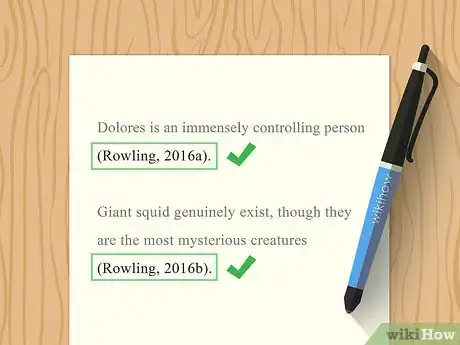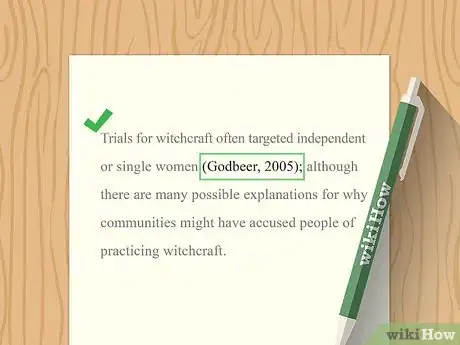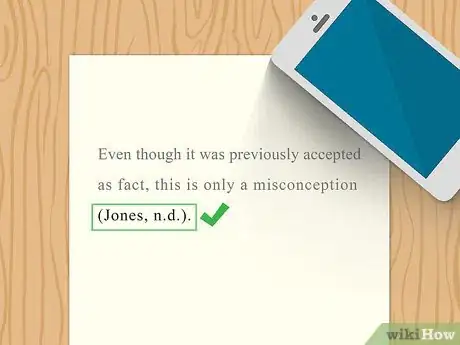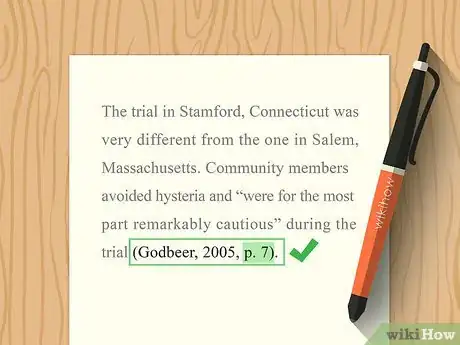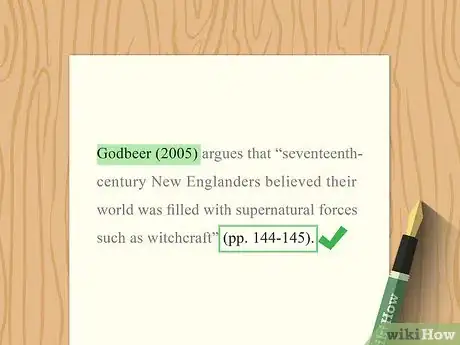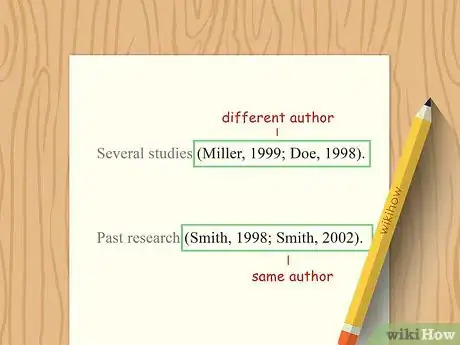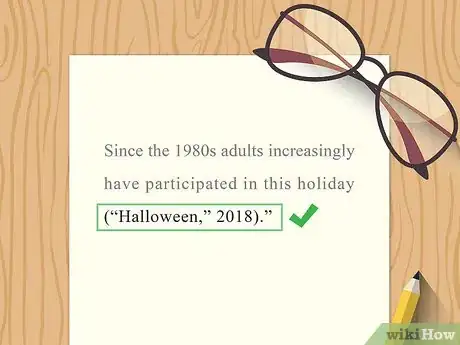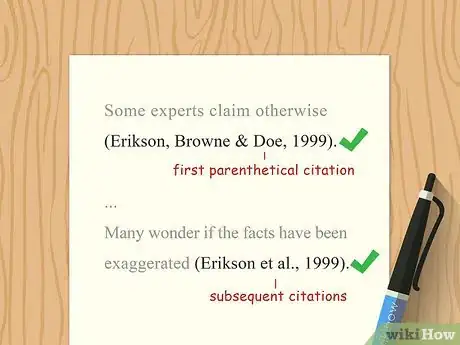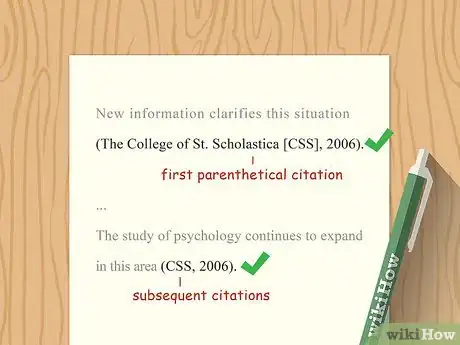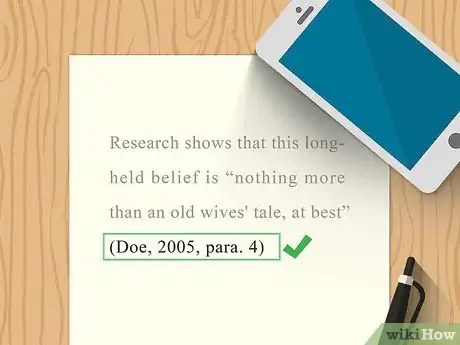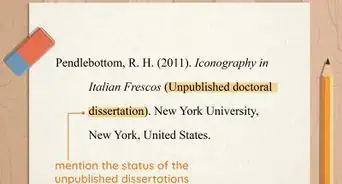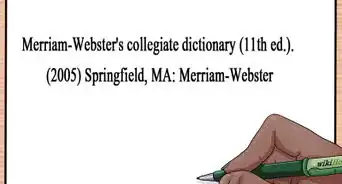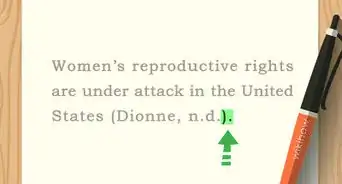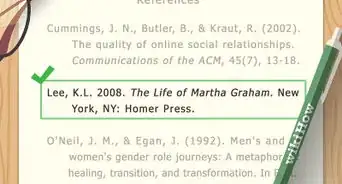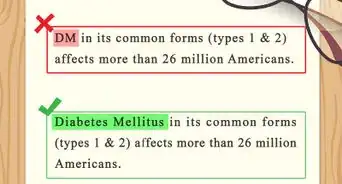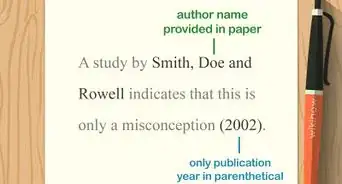This article was co-authored by Christopher Taylor, PhD. Christopher Taylor is an Adjunct Assistant Professor of English at Austin Community College in Texas. He received his PhD in English Literature and Medieval Studies from the University of Texas at Austin in 2014.
There are 8 references cited in this article, which can be found at the bottom of the page.
This article has been viewed 38,108 times.
APA is the citation style of the American Psychological Association. It’s usually used by students and researchers in social science fields, including psychology, education, and management.[1] APA in-text citations are actually quite easy to add to your paper. For each source you’re referencing, just place the author’s last name and the publication date in parentheses at the end of the sentence. For more complex sources (like books with multiple authors), you’ll need to add just a few more details.
Steps
Doing a Basic In-Text Citation
-
1Place in-text citations at the end of the sentence with the reference. In-text citations should be provided to readers immediately after you’ve quoted, paraphrased, or referred to information from a source. This will avoid any confusion about where the cited information comes from. The citation should come after the last word of the sentence but before the period. Put all in-text citations in parentheses.[2]
- An APA in-text citation for the book Escaping Salem: The Other Witch Hunt of 1692 by Richard Godbeer (2005) would look like this: “While many people immediately think of Salem, Massachusetts when they are asked about witchcraft in America, trials took place in other communities, as well (Godbeer, 2005).”
- Your reference list (which comes at the end of your paper) will include more information on each source, including the title and publication location.
-
2Use small letters for sources by 1 author published in the same year. If you’re citing 2 sources by the same author published in the exact same year, it’s important to differentiate between them. Label them with “a,” “b,” “c,” and so on right at the end of the in-text citation.[3]
- For example, “(Godbeer, 2005a)” and “(Godbeer, 2005b).”
Advertisement -
3Include the citation at the end of a clause for long sentences. If the sentence has lots of different clauses, it might get confusing for the reader if you put the citation all the way at the end of the line. Instead, include the citation at the end of the clause where you’ve referenced the source.[4]
- For example, you might write, “Trials for witchcraft often targeted independent or single women (Godbeer, 2005); although there are many possible explanations for why communities might have accused people of practicing witchcraft.”
-
4Include the author’s last name and year of publication. Unlike some other citation styles (like Chicago), APA doesn’t make you include very much information in your in-text citations. If you’re citing a source with 1 identifiable author, all you need is the author’s last name and the publication date.[5]
- Use “n.d.” (meaning “no date”) if no publication date is provided.[6]
-
5Include the page number(s) for quotations. When you’re quoting from a book rather than just referring to it or paraphrasing the author’s argument, page numbers are needed to tell your reader exactly where they can find the quotation. For a single page, use the letter “p” followed by a period: “p.” For more than one page, use two p’s followed by a period: “pp.”[7]
- An in-text citation for a quotation would look like this: “The witchcraft trial in Stamford, Connecticut was very different from the one in Salem, Massachusetts. Community members avoided hysteria and “were for the most part remarkably cautious” during the trial (Godbeer, 2005, p. 7).”
-
6Leave out the author’s last name if you state it in the sentence. There might be times when you’d like to directly refer to the author in your sentence. Since you’ve done this, you don’t have to repeat the author’s last name in your in-text citation. Type out the publication date in parentheses immediately after you’ve stated the author’s name. If you’re quoting from a source, add the page numbers in parentheses at the end of the sentence.[8]
- This type of in-text citation might look like this: “Godbeer (2005) argues that “seventeenth-century New Englanders believed their world was filled with supernatural forces” such as witchcraft” (pp. 144-145).
-
7Separate more than 1 source with a semicolon. If you’re citing 2 sources in the same sentence, it’s important to make that clear to your reader. You’ll need to include both authors’ last names and the publication dates of the 2 sources in parentheses at the end of the sentence.[9] Order the 2 sources alphabetically within the parentheses. If you’re citing 2 sources by the same author, order them by their publication date, with older sources coming before newer ones.[10]
- For example, perhaps you want to cite both Escaping Salem and The Devil in the Shape of a Woman: Witchcraft in Colonial New England (1998) by Carol F. Karlsen. Your in-text citation would look like this: “(Karlsen, 1998; Godbeer, 2005).”
- If you were citing Escaping Salem and Richard Godbeer’s earlier book, The Devil’s Dominion: Magic and Religion in Early New England (1992), your citation would look like this: “(Godbeer, 1992; Godbeer, 2005).”
Making In-Text Citations for Complex Sources
-
1Use a shortened version of the title if there’s no author. You might occasionally encounter sources that don’t provide you with the author’s name. Shorten the title by skipping words like “the,” “an,” and other non-specific words that won’t help the reader identify the source. Instead, use the first 2 or 3 major words of the title. Italicize book titles and put article titles, encyclopedia entries, and the names of websites inside quotation marks.[11]
- For example, an in-text citation for the encyclopedia entry “Halloween” in the Encyclopedia of American Studies (2016) would look like this: “(“Halloween,” 2006).”
-
2Use the “&” symbol for 2-5 authors in the first citation. List the authors’ last names in the order they appear on the title page. If there are just 2, separate them with “&.” If there are between 3 and 5, separate all of the last names with commas and add “&” before the final author’s last name. After you do this in 1 citation, replace all but the first author’s last name with “et al” in the rest of your citations.[12]
- For example, the in-text citation for The Gothic World of Anne Rice, edited by Gary Hoppenstand and Ray B. Browne (1996) would look like this, “(Hoppenstand & Browne, 1996)” for the first citation and this, “(Hoppenstand et al., 1996)” for every subsequent citation.
- For sources with 6 or more authors, you’ll replace all but the first author’s last name with “et al” in all of your in-text citations.[13]
-
3Abbreviate organization names when possible. Some sources will be written by organizations (like the American Psychological Association) rather than single authors. Use the full name of the organization in the first in-text citation and place the official abbreviation inside brackets. For subsequent in-text citations, use only the official abbreviation.[14]
- If you were citing the 6th edition of the APA’s Publication Manual (2009), for example, your first in-text citation would look like this: “(American Psychological Association [APA], 2009).”
- You’ll be able to tell if an organization has an official abbreviation by looking at documents or publications prepared by that organization. For example, the World Health Organization (WHO) refers to itself as “WHO” on its website.[15]
-
4Use paragraph numbers for quotes from sources without page numbers. If you’re including a direct quote, you always need to point your reader in the direction of that quote. For sources that don’t include page numbers (like websites and some eBooks), this can be tricky. Include the paragraph number by abbreviating paragraph in your in-text citation, like so: “(Godbeer, 2005, para. 4)”.[16]
- If no author is provided, you might be able to include the name of the organization that published the source. Otherwise, include a shortened title of the source.
- If you can’t find a publication date, write “n.d.” instead.
- If you’re citing an entire website article (rather than quoting a specific part), your in-text citation should include the author and publication date as usual.
References
- ↑ http://libguides.css.edu/c.php?g=41681&p=265025
- ↑ http://guides.libraries.psu.edu/apaquickguide/intext
- ↑ http://guides.libraries.psu.edu/apaquickguide/intext
- ↑ http://guides.libraries.psu.edu/apaquickguide/intext
- ↑ http://guides.libraries.psu.edu/apaquickguide/intext
- ↑ https://awc.ashford.edu/cd-in-text-citation-guide.html
- ↑ https://owl.purdue.edu/owl/research_and_citation/apa_style/apa_formatting_and_style_guide/in_text_citations_the_basics.html
- ↑ https://owl.purdue.edu/owl/research_and_citation/apa_style/apa_formatting_and_style_guide/in_text_citations_the_basics.html
- ↑ http://libguides.css.edu/c.php?g=41681&p=265025
- ↑ http://www.apastyle.org/learn/faqs/references-in-parentheses.aspx
- ↑ https://aus.libguides.com/apa/apa-no-author-date
- ↑ https://owl.purdue.edu/owl/research_and_citation/apa_style/apa_formatting_and_style_guide/in_text_citations_author_authors.html
- ↑ http://libguides.css.edu/c.php?g=41681&p=265025
- ↑ http://libguides.css.edu/c.php?g=41681&p=265025
- ↑ https://www.who.int/about
- ↑ https://owl.purdue.edu/owl/research_and_citation/apa_style/apa_formatting_and_style_guide/in_text_citations_author_authors.html
- ↑ http://libguides.css.edu/c.php?g=41681&p=265025
About This Article
To do an APA in-text citation, place the citation in parentheses at the end of the sentence you're using a reference in but before the period. Inside the parentheses, include the author's last name, followed by a comma and the date of publication. If you can't find the date of publication, write "n.d." instead. Also, if you're using a direct quote, include the page number it's on after the date of publication. For more tips from our English co-author, like how to cite complex sources in text, scroll down!

